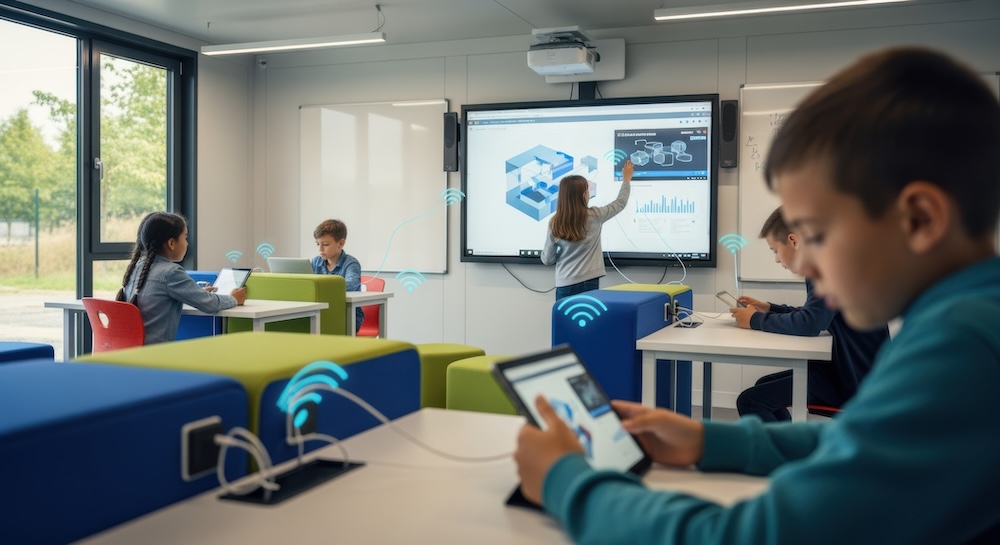Technology in education is evolving faster than ever. In just a few short years, classrooms have gone from projectors and computer labs to cloud-based learning platforms, one-to-one devices, and AI-driven tutoring tools. As schools plan for 2026, they are rethinking how to use technology — not just to teach, but to create more connected, efficient, and secure learning environments.
Below are some of the key technology trends expected to shape K–12 and higher education in 2026, and what they could mean for schools preparing for the next wave of innovation.
1. AI Moves from Experiment to Everyday
Artificial intelligence is becoming an integral part of education. By 2026, the focus is expected to shift from whether to use AI to how to use it responsibly.
Schools may integrate AI tools to:
- Personalize learning by adapting lessons and assessments to each student’s progress.
- Automate administrative tasks such as grading, attendance tracking, and document management.
- Enhance tutoring and support, with AI chatbots helping students review lessons, write essays, or practice new concepts outside of class hours.
AI adoption also raises challenges around data privacy, security, and transparency. Schools are likely to develop policies that keep student data protected while allowing teachers to retain control over classroom use.
The key shift by 2026: AI won’t replace teachers; it will help them focus more on teaching and less on paperwork.

2. Hybrid Learning Becomes the New Normal
The pandemic accelerated the adoption of digital learning tools. Looking ahead to 2026, hybrid learning models are expected to become even more powerful, combining the best of in-person and online education.
Students will increasingly expect flexible, tech-supported learning environments that allow them to access materials from anywhere. Cloud-based platforms like Microsoft Teams, Google Workspace for Education, and Canvas will likely continue to be central to collaboration and lesson planning.
Administrators will need to invest in secure networks, reliable Wi-Fi, and tools that support learning both on and off campus. The goal: fewer disruptions, more continuity, and better preparedness for any scenario that might shift learning online.
3. Cybersecurity Takes Center Stage
As digital learning expands, so does the risk. Schools are increasingly attractive targets for cyberattacks due to the sensitive data they hold and sometimes outdated systems.
By 2026, school leaders are expected to prioritize cybersecurity across all levels. Districts may strengthen authentication, conduct regular security assessments, and train staff and students on best practices.
Printing and document systems can also pose vulnerabilities. Schools looking ahead are likely to manage access, automate software updates, and use monitoring tools to track document usage.
Bottom line: protecting student data and learning continuity will be a top concern for educational leaders.
4. Sustainability Drives Tech Decisions
Sustainability goals are reshaping technology decisions in schools. From reducing paper use to implementing energy-efficient devices, districts are expected to pay closer attention to how their technology affects both budgets and the environment.
Some of the most visible changes may include:
- Print optimization: Moving toward digital workflows and secure print release to reduce waste.
- Device lifecycle management: Extending the lifespan of hardware through better maintenance and responsible recycling programs.
- Green IT initiatives: Selecting energy-efficient equipment and using data analytics to monitor power consumption across campuses.
Many schools will view sustainability not just as a “nice-to-have,” but as a teaching opportunity, modeling environmental responsibility for students through everyday choices.

5. Data-Driven Decision Making Expands
School administrators have always tracked student performance and resource use, but by 2026, analytics tools are expected to take that to the next level.
Modern education systems may integrate data from multiple sources, including attendance, assessments, behavior, network usage, and even printing activity, to help leaders make more informed decisions.
With the right dashboards, schools could:
- Identify learning gaps earlier.
- Allocate resources more efficiently.
- Monitor IT performance and address issues before they cause downtime.
The shift toward data-driven insights is transforming how schools plan budgets, track outcomes, and measure success. It’s also improving transparency and accountability for administrators, teachers, and parents alike.
6. Cloud Infrastructure Matures
Cloud computing will continue to reshape how schools deploy and manage technology. By 2026, cloud platforms are expected to simplify everything from lesson planning to device management to application hosting.
Cloud adoption can help schools:
- Support hybrid learning environments with consistent access.
- Reduce dependence on on-site servers and maintenance costs.
- Scale easily as enrollment or program needs change.
IT teams may also gain tools to manage updates, monitor performance, and enforce security policies remotely — saving time and ensuring systems stay current and compliant.
7. Classroom Technology Gets Smarter (and Simpler)
Interactive whiteboards, digital displays, and classroom AV systems are evolving to become more intuitive and integrated. By 2026, teachers may no longer need to juggle multiple remotes or software tools to run a lesson, as most systems are expected to connect seamlessly with devices and learning platforms.
The focus will likely shift from having more technology to having better, more user-friendly technology that enhances engagement without adding complexity.
Many schools may also rethink classroom design, creating flexible, connected spaces where students can collaborate, share screens, and participate in both in-person and virtual lessons.
The goal for 2026: make technology an invisible helper, not a distraction.

8. Document Workflows Go Digital
Even as schools digitize, printed documents aren’t going away completely — they’re just being managed more intelligently.
By 2026, document management tools are expected to help schools simplify everyday tasks such as:
- Enrollment and registration
- Permission forms and compliance paperwork
- HR and finance documentation
- Classroom materials and testing
Automating these workflows reduces manual data entry, improves accuracy, and keeps staff focused on students rather than paperwork. Secure cloud storage and digital signatures also make it easier to share and archive records safely.
The result is a faster, more transparent process and significant time savings across departments.
9. Networking and Connectivity Upgrades
As more learning tools move online, reliable connectivity will become as essential as electricity. Many districts are expected to invest heavily in network upgrades to handle increased bandwidth demand and ensure equitable access for all students.
By 2026, schools may see expanded use of:
- Wi-Fi 7 for faster, more stable wireless coverage
- Private 5G networks in large campuses
- Edge computing to speed up local data processing
Strong network foundations will also support newer technologies like AR/VR learning, cloud-based testing, and connected campus security systems. Simply put, without a solid network, even the best education tools can fall short.
10. Focus on Digital Equity
One of the most important ongoing trends is digital equity — ensuring that every student has equal access to technology, regardless of background or location.
Districts are expected to expand device programs, offer subsidized internet access, and integrate digital literacy into the curriculum. IT and administrative leaders will also continue seeking ways to make technology management more efficient, helping limited budgets go further.
When technology is reliable and accessible, students are empowered to learn, and teachers can focus on teaching rather than troubleshooting.
Preparing for What’s Next
If there’s one common thread across all these trends, it’s this: schools are moving from technology adoption to technology optimization. The goal isn’t just to add new tools, but to connect them, secure them, and make them work better together.
That requires thoughtful planning around infrastructure, cybersecurity, data management, and sustainability — the invisible systems that make modern education run smoothly.
Every year, UBS attends the New Jersey School Boards Association Workshop, where educators, IT directors, and school administrators come together to share insights and challenges. These conversations offer valuable perspective into how technology is reshaping classrooms and where schools may need the most support. Whether it’s finding ways to protect student data, manage devices more efficiently, or streamline document workflows, the discussions consistently highlight one theme: using technology to create better learning experiences.
By paying attention to these trends, schools can build learning environments that are not only more innovative but also resilient, efficient, and student-centered — ready for the opportunities and challenges of 2026.
About United Business Systems
United Business Systems specializes in simplifying the complexity and management of office technology solutions for over 7,800 organizations nationwide. Services include Managed Print, Document Management and IT Services. Products include MFPs, Copiers, Printers and Wide Format Printers. UBS’s headquarters is in Fairfield, NJ with branch offices in Moorestown, NJ, Manasquan, NJ and New York.For the latest industry trends and technology insights visit UBS’ main Blog page.


